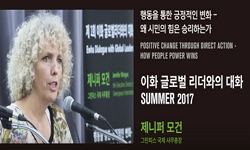이 연구는 한국과 일본의 반핵 운동에 대한 비교와 반핵 운동의 영향 요인을 분석한다. 한국과 일본은 정부 주도의 발전 정책과 유교 문화 영향의 수직적 관계 구조를 가지고 있다. 2차 대전 ...
http://chineseinput.net/에서 pinyin(병음)방식으로 중국어를 변환할 수 있습니다.
변환된 중국어를 복사하여 사용하시면 됩니다.
- 中文 을 입력하시려면 zhongwen을 입력하시고 space를누르시면됩니다.
- 北京 을 입력하시려면 beijing을 입력하시고 space를 누르시면 됩니다.

Development of Anti-nuclear Movements and Factors Affecting Them in South Korea and Japan = A Comparative Perspective
한글로보기https://www.riss.kr/link?id=A99664950
- 저자
- 발행기관
- 학술지명
- 권호사항
-
발행연도
2013
-
작성언어
English
- 주제어
-
등재정보
KCI등재
-
자료형태
학술저널
-
수록면
7-43(37쪽)
- 제공처
-
0
상세조회 -
0
다운로드
부가정보
국문 초록 (Abstract)
이 연구는 한국과 일본의 반핵 운동에 대한 비교와 반핵 운동의 영향 요인을 분석한다. 한국과 일본은 정부 주도의 발전 정책과 유교 문화 영향의 수직적 관계 구조를 가지고 있다. 2차 대전 이후, 한ㆍ일 양국은 정치ㆍ경제적으로 비슷한 발전 경로를 가지고 있지만 사회ㆍ문화적으로는 차이가 있다. 양국은 원자력 발전과정과 마찬가지로 반핵운동에 있어서도 공통점과 차이점이 있다. 후쿠시마 원자력 사고 이후 반핵 운동이 사회적인 문제로 대두되었으나 2년이 지난 현재에는 영향력과 관심이 현저히 줄어들었다. 이 연구는 정치적 기회 구조에 초점을 맞춘 해석적 연구를 다루며 원자력과 관련한 사건들을 사회역사적인 관점으로 바라보고 있다. 원자력 관련 사건이 발생하면, 한국과 일본 정부는 단편적인 접근을 통해 원자력 안전 문제를 다루려고 한다. 정부는 원자력 발전 시설 설립이 계획된 지역 주민들에게 일련의 경제적 유인책을 제시하고, 이러한 경제적 영향력으로 인해 반핵운동은 지지 기반을 잃게 된다. 2011년 3월 후쿠시마 사건 이후, 한국과 일본에서 반핵 운동과 관련된 환경단체와 시민단체의 활동이 증가하고 있다. 그러나 두 국가는 원자력 정책에 있어서 다른 길을 걷고 있으며 반핵운동의 활동 양상도 다르다. 연구는 일련의 환경 운동이 경제 발전이 우선시되는 시대적 상황에서 어떻게 전개 되어 가는지에 대한 시사점과 향후 반핵 운동의 방향성에 대한 함의를 줄 수 있으리라 기대된다.
다국어 초록 (Multilingual Abstract)
This paper offers a comparative analysis of development of anti-nuclear movements and factors affecting the movements in South Korea and Japan. Both countries have government-led development policies, and the vertical structuring of relationships unde...
This paper offers a comparative analysis of development of anti-nuclear movements and factors affecting the movements in South Korea and Japan. Both countries have government-led development policies, and the vertical structuring of relationships under the influence of Confucian tradition. After the World War Ⅱ, they have the similar development path in political and economical context but they have differences in social andcultural context. They have similarities and differences regarding the nuclear development paths and anti-nuclear movements. After the Fukushima accident, the nuclear security issue came to the fore but two years later, its interest slowly decreased. This study pays attention to an interpretive concept which focuses on political opportunity structures and to the socio-historical perspective on events. When nuclear power accidents occur, governments try to deal with nuclear safety issues in a piecemeal approach. They have offered a series of economic inducements to those who live in the proposed site for nuclear facilities. From an economic leverage, anti-nuclear activists have been losing ground in both countries. After the Fukushima disaster in March, 2011, there is an increase of grass root level activities in environmental groups and civic groups regarding anti-nuclear movements in South Korea and Japan. But two countries have gone to different paths in nuclear policies and anti-nuclear movements. This study has implications on the environmental movements in a situation which has priority over the economic development and shows the directions of the further anti-nuclear movements.
목차 (Table of Contents)
- 1. Introduction
- 2. Theoretical methods and research
- 3. The National Context
- 4. Factors affecting anti-nuclear movements in South Korea and Japan
- 5. Conclusion
- 1. Introduction
- 2. Theoretical methods and research
- 3. The National Context
- 4. Factors affecting anti-nuclear movements in South Korea and Japan
- 5. Conclusion
- References
- ENGLISH ABSTRACT
동일학술지(권/호) 다른 논문
-
- 한국환경사회학회
- 강윤재(Yunjae Kang)
- 2013
- KCI등재
-
- 한국환경사회학회
- 구도완(Dowan Ku)
- 2013
- KCI등재
-
- 한국환경사회학회
- 김도균(Do-Kyun Kim)
- 2013
- KCI등재
-
- 한국환경사회학회
- 김지원(Jiwon Kim)
- 2013
- KCI등재




 KCI
KCI DBpia
DBpia






